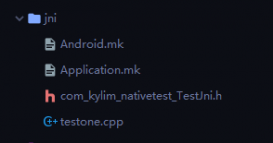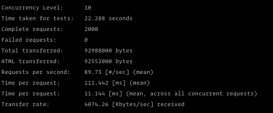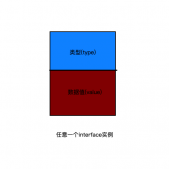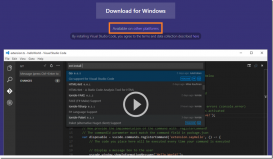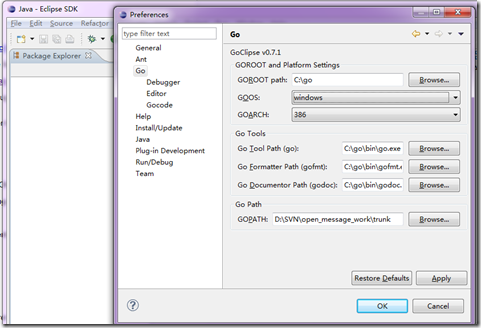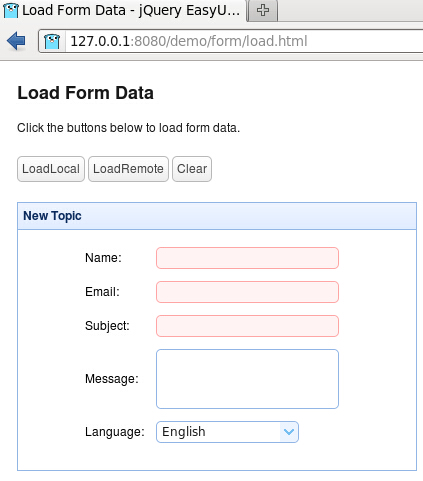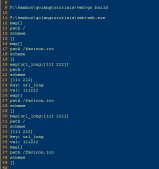以下源码都摘自 golang 1.16.15 版本。
1. channel 底层结构
Golang 中的 channel 对应的底层结构为 hchan 结构体(channel的源码位置在Golang包的 runtime/chan.go):
|
1
2
3
4
5
6
7
8
9
10
11
12
13
|
type hchan struct { qcount uint // buf当前元素的数量 dataqsiz uint // buf的容量 buf unsafe.Pointer // channel缓冲区,一个循环数组 elemsize uint16 // 元素大小 closed uint32 // channel关闭标记 elemtype *_type // element type sendx uint // 当下一次发送数据到channel时,数据存放到buf中的哪个index recvx uint // 当下一次从channel接收数据时,从buf的哪个index获取数据 recvq waitq // 等待接收数据的goroutine列表,双向链表 sendq waitq // 等待发送数据的goroutine列表,双向链表 lock mutex // 互斥锁,发送和接收操作前需要获取的锁,所以channel的发送和接收操作是互斥的} |
如果 dataqsiz == 0 时,则为无缓冲 channel,如果 dataqsiz > 0 时,则为有缓冲 channel。
其中 recvq 和 sendq 是一个双向链表结构,链表中的元素为 sudog 结构体,其中该结构体中保存了g,所以本质上recvq 和 sendq 是保存了等待接收/发送数据的goroutine列表。
channel 中的 recvq 和 sendq 的使用场景如下所示:
在从 channel 接收数据时 (data := <- ch),如果 sendq 中没有等待发送数据的 goroutine,且 buf 中没有数据时,则需要把当前 goroutine 保存到 recvq 列表中,并挂起。
在向 channel 发送数据时 (ch <- data),如果 recvq 中没有等待接收数据的 goroutine,且 buf 满了的情况下,则需要把当前 goroutine 保存到 sendq 列表中,并挂起。
|
1
2
3
4
|
type waitq struct { first *sudog last *sudog} |
|
1
2
3
4
5
6
7
8
9
10
11
12
13
14
15
16
17
18
19
20
21
22
23
24
25
26
27
|
// sudog表示等待队列中的一个g,例如在一个channel中的发送/接收。// sudog是必要的,因为g和同步对象的关系是多对多的,一个g可以在多个等待队列中,因此一个g会有很多个sudog,// 很多g可能在等待着同一个同步对象,因此一个对象可能有多个sudog。// sudog是从一个特殊的池中分配的,使用acquireSudog和releaseSudog分配和释放它们。type sudog struct { // 以下字段受此sudog阻塞的channel的hchan.lock保护 g *g next *sudog prev *sudog elem unsafe.Pointer // data element (may point to stack) // 以下字段永远不会被同时访问 // 对于channel,waitlink只能被g访问 // 对于信号量,所有字段(包括上述字段)只有在持有semaRoot锁时才能访问。 acquiretime int64 releasetime int64 ticket uint32 // isSelect表示g正在参与选择,因此g.selectDone必须经过CAS处理,才能被唤醒 isSelect bool // success表示通过channel c的通信是否成功。 // 如果goroutine因为通过channel c传递了一个值而被唤醒,则为true // 如果因为c被关闭而唤醒,则为false success bool parent *sudog // semaRoot binary tree waitlink *sudog // g.waiting list or semaRoot waittail *sudog // semaRoot c *hchan // channel} |
channel 结构图:
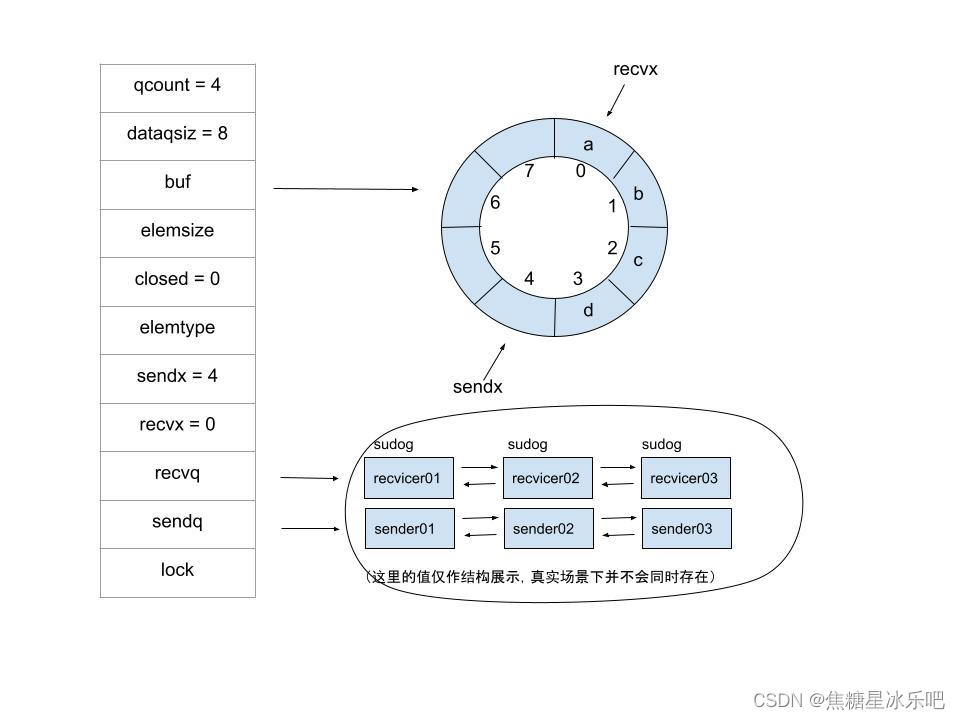
2. channel 的创建
|
1
2
3
4
|
// 无缓冲channelch := make(chan int)// 缓冲大小为5的channelch2 := make(chan int, 5) |
创建 channel 的源码为runtime/chan.go文件中的 makechan 函数:
|
1
2
3
4
5
6
7
8
9
10
11
12
13
14
15
16
17
18
19
20
21
22
23
24
25
26
27
28
29
30
31
32
33
34
35
36
37
38
39
40
41
42
43
44
45
46
|
func makechan(t *chantype, size int) *hchan { elem := t.elem // compiler checks this but be safe. if elem.size >= 1<<16 { throw("makechan: invalid channel element type") } if hchanSize%maxAlign != 0 || elem.align > maxAlign { throw("makechan: bad alignment") } mem, overflow := math.MulUintptr(elem.size, uintptr(size)) if overflow || mem > maxAlloc-hchanSize || size < 0 { panic(plainError("makechan: size out of range")) } // Hchan does not contain pointers interesting for GC when elements stored in buf do not contain pointers. // buf points into the same allocation, elemtype is persistent. // SudoG's are referenced from their owning thread so they can't be collected. // TODO(dvyukov,rlh): Rethink when collector can move allocated objects. var c *hchan switch { case mem == 0: // 队列或元素大小为0,即无缓冲channel c = (*hchan)(mallocgc(hchanSize, nil, true)) // Race detector uses this location for synchronization. c.buf = c.raceaddr() case elem.ptrdata == 0: // 元素不包含指针类型,只进行一次 hchan 和 buf 的内存分配 // 当存储在buf中的元素不包含指针时,GC就不会扫描hchan中的元素 c = (*hchan)(mallocgc(hchanSize+mem, nil, true)) c.buf = add(unsafe.Pointer(c), hchanSize) default: // 元素中包含指针类型,进行2次内存分配操作 // 用new分配内存返回的是指针 c = new(hchan) c.buf = mallocgc(mem, elem, true) } // 初始化channel数据 c.elemsize = uint16(elem.size) c.elemtype = elem c.dataqsiz = uint(size) lockInit(&c.lock, lockRankHchan) if debugChan { print("makechan: chan=", c, "; elemsize=", elem.size, "; dataqsiz=", size, "\n") } // 返回 hchan 的指针类型 return c} |
注意这里返回的是 hchan 的指针,因此我们在函数间可以直接传递 channel,而不用传递channel的指针了。
另外,因为channel 的内存分配都用到了 mallocgc 函数,而 mallocgc 是负责堆内存分配的关键函数,因此可见 channel 是分配在堆内存上的。
3. channel 的发送流程

channel 的发送:
ch <- data
channel 发送的源码对应 runtime/chan.go 的 chansend 函数:
|
1
2
3
4
5
6
7
8
9
10
11
12
13
14
15
16
17
18
19
20
21
22
23
24
25
26
27
28
29
30
31
32
33
34
35
36
37
38
39
40
41
42
43
44
45
46
47
48
49
50
51
52
53
54
55
56
57
58
59
60
61
62
63
64
65
66
67
68
69
70
71
72
73
74
75
76
77
78
79
80
81
82
83
84
85
86
87
88
89
90
91
92
93
94
95
96
97
98
99
100
101
102
103
104
105
106
107
108
109
110
111
112
113
114
115
116
117
118
|
func chansend(c *hchan, ep unsafe.Pointer, block bool, callerpc uintptr) bool { // 如果当前channel是nil if c == nil { // 如果不阻塞,则直接返回false if !block { return false } // 挂起当前goroutine gopark(nil, nil, waitReasonChanSendNilChan, traceEvGoStop, 2) throw("unreachable") } if debugChan { print("chansend: chan=", c, "\n") } if raceenabled { racereadpc(c.raceaddr(), callerpc, funcPC(chansend)) } // 这里访问了hchan结构中的closed, full函数内部访问了dataqsiz,recvq,qcount字段,这里没有加锁,是为什么呢? // 先说说这里判断的含义:如果不阻塞,且channel没有被关闭,且buf已满,则快速返回false,表示数据发送失败。 // 因为没有加锁,假如在判断c.closed == 0之后结果为true,在判断full之前,这时channel被其他goroutine关闭了, // 然后full函数返回了true,那么它会直接return false,这样子会有什么影响呢? // 其实并没有什么影响,在这种情况下返回false也是合理的,因为都是表示在不阻塞的情况下发送数据失败。 // 所以这里访问hchan里面的数据就没有加锁了 if !block && c.closed == 0 && full(c) { return false } var t0 int64 if blockprofilerate > 0 { t0 = cputicks() } // 锁住channel,可见channel是并发安全的 lock(&c.lock) // 如果channel已关闭,则panic if c.closed != 0 { unlock(&c.lock) panic(plainError("send on closed channel")) } // 如果recvq等待接收队列中有值,则直接把值传给等待接收的goroutine,这样可以减少一次内存拷贝 if sg := c.recvq.dequeue(); sg != nil { send(c, sg, ep, func() { unlock(&c.lock) }, 3) return true } // 如果recvq等待接收队列中没有值,且为有缓冲channel,则把数据copy到buf中 if c.qcount < c.dataqsiz { // Space is available in the channel buffer. Enqueue the element to send. qp := chanbuf(c, c.sendx) if raceenabled { racenotify(c, c.sendx, nil) } typedmemmove(c.elemtype, qp, ep) c.sendx++ // 因为buf是环形数组,所以如果sendx超出了最大index,就要归0 if c.sendx == c.dataqsiz { c.sendx = 0 } c.qcount++ unlock(&c.lock) return true } // 如果recvq等待接收队列中没有值,且为无缓冲channel,且不阻塞,则直接返回false if !block { unlock(&c.lock) return false } // 接下来做阻塞当前goroutine的一些准备工作,构造一个sudog // 获取当前goroutine的指针 gp := getg() mysg := acquireSudog() mysg.releasetime = 0 if t0 != 0 { mysg.releasetime = -1 } // No stack splits between assigning elem and enqueuing mysg // on gp.waiting where copystack can find it. mysg.elem = ep mysg.waitlink = nil mysg.g = gp mysg.isSelect = false mysg.c = c gp.waiting = mysg gp.param = nil // 把构建好的 sudog 加到 sendq 发送等待队列中 c.sendq.enqueue(mysg) // Signal to anyone trying to shrink our stack that we're about // to park on a channel. The window between when this G's status // changes and when we set gp.activeStackChans is not safe for // stack shrinking. atomic.Store8(&gp.parkingOnChan, 1) // 挂起当前goroutine gopark(chanparkcommit, unsafe.Pointer(&c.lock), waitReasonChanSend, traceEvGoBlockSend, 2) // 如果当前 goroutine 被唤醒后,会在这里继续执行 // Ensure the value being sent is kept alive until the // receiver copies it out. The sudog has a pointer to the // stack object, but sudogs aren't considered as roots of the // stack tracer. KeepAlive(ep) // someone woke us up. if mysg != gp.waiting { throw("G waiting list is corrupted") } gp.waiting = nil gp.activeStackChans = false closed := !mysg.success gp.param = nil if mysg.releasetime > 0 { blockevent(mysg.releasetime-t0, 2) } mysg.c = nil releaseSudog(mysg) if closed { if c.closed == 0 { throw("chansend: spurious wakeup") } // 如果唤醒后,发现 channel 被关闭,则关闭 panic(plainError("send on closed channel")) } return true} |
full 函数,用于判断当前channel是否还有坑位接收待发送的数据:
|
1
2
3
4
5
6
7
8
9
10
|
// 判断channel中是否还有位置存放数据func full(c *hchan) bool { // 如果是非缓冲channel if c.dataqsiz == 0 { // 如果 recvq 中没有等待接收数据的 goroutine,则返回 true,表示已满,否则返回 false return c.recvq.first == nil } // 如果是有缓冲 channel,则判断buf是否已满 return c.qcount == c.dataqsiz} |
send 函数,在recvq中有等待接收数据的goroutine时会被调用:
|
1
2
3
4
5
6
7
8
9
10
11
12
13
14
15
16
17
18
19
20
21
22
23
24
25
26
27
28
29
30
31
32
33
34
35
36
37
38
39
40
|
// 在一个空的 channel c 中完成发送操作// 把数据 ep 从发送者复制到接收者 sg 中// 最后接收的 goroutine 会被唤醒// channel c 一定是空的且被锁住的// sg 一定是已经从 c 的 recvq 中出队了// eq 一定是不等于 nil 的,且指向堆或者是调用者的栈func send(c *hchan, sg *sudog, ep unsafe.Pointer, unlockf func(), skip int) { if raceenabled { if c.dataqsiz == 0 { racesync(c, sg) } else { // Pretend we go through the buffer, even though // we copy directly. Note that we need to increment // the head/tail locations only when raceenabled. racenotify(c, c.recvx, nil) racenotify(c, c.recvx, sg) c.recvx++ if c.recvx == c.dataqsiz { c.recvx = 0 } c.sendx = c.recvx // c.sendx = (c.sendx+1) % c.dataqsiz } } // sg.elem 指向接收者存放接收数据的存放的位置 if sg.elem != nil { // 直接内存拷贝,从发送者拷贝到接收者内存 sendDirect(c.elemtype, sg, ep) sg.elem = nil } gp := sg.g // 解锁 unlockf() gp.param = unsafe.Pointer(sg) sg.success = true if sg.releasetime != 0 { sg.releasetime = cputicks() } // 唤醒接收数据的goroutine goready(gp, skip+1)} |
总结 channel 的发送流程:
判断 channel 是否是 nil,如果是,则会永久阻塞导致死锁报错
如果 channel 中 recvq 存在接收者 goroutine,则直接把需要发送的数据拷贝到接收 goroutine,这里其实是有sodog 的结构,里面保存了接受者goroutine的指针。
如果 recvq 中不存在接收者:
a. 如果 buf 没有满,则直接把数据拷贝到 buf 的 sendx 位置
b. 如果 channel 为无缓冲 channel 或 buf 已满,则把当前 goroutine 保存到 sendq 等待队列中,阻塞当前 goroutine
4. channel 的接收流程
channel 的接收:
data := <- ch
data2, ok := <- ch
channel 的接收分别有2个函数,其中一种是带”ok“返回值的,另外一种是不带"ok"返回值的。
- 带”ok"返回值的函数,该返回的布尔值为 true 时,并不表示当前通道还没有关闭,而是仅仅表示当前获取到的值是通道的正常生产出来的数据,而不是零值;当该布尔值为 false 时,表示当前的通道已经被关闭,并且获取到的值是零值。
- 不带"ok"返回值的函数,当 channel 被关闭时,就不能判断当前获取到的值是 channel 正常生产的值,还是零值了。
|
1
2
3
4
5
6
7
8
9
|
// 无返回值func chanrecv1(c *hchan, elem unsafe.Pointer) { chanrecv(c, elem, true)}// 返回 bool 类型,如果返回false,表示 channel 已经被关闭,否则返回false。 func chanrecv2(c *hchan, elem unsafe.Pointer) (received bool) { _, received = chanrecv(c, elem, true) return} |
不管是否返回 received,channel 的接收都调用了 chanrecv 函数:
|
1
2
3
4
5
6
7
8
9
10
11
12
13
14
15
16
17
18
19
20
21
22
23
24
25
26
27
28
29
30
31
32
33
34
35
36
37
38
39
40
41
42
43
44
45
46
47
48
49
50
51
52
53
54
55
56
57
58
59
60
61
62
63
64
65
66
67
68
69
70
71
72
73
74
75
76
77
78
79
80
81
82
83
84
85
86
87
88
89
90
91
92
93
94
95
96
97
98
99
100
101
102
103
104
105
106
107
108
109
110
111
112
113
114
115
116
117
118
119
120
121
122
123
124
125
126
127
128
129
130
131
132
133
134
135
136
137
138
139
140
141
142
143
144
145
146
147
|
// 从 channel c 中接收数据,并把数据复制到 ep 中。// 在忽略接收数据的情况下,eq 可能是 nil,例如:<- ch// 如果不阻塞,且 channel 中没有元素的情况下,直接快速返回(false, false)// 如果 c 已经被关闭,*ep 为零值,怎返回(true, false)// 如果 *ep 中有元素,则返回(true, true)// 一个不等于 nil 的 eq 一定指向堆或者调用者的栈func chanrecv(c *hchan, ep unsafe.Pointer, block bool) (selected, received bool) { // raceenabled: don't need to check ep, as it is always on the stack // or is new memory allocated by reflect. if debugChan { print("chanrecv: chan=", c, "\n") } if c == nil { if !block { return } // 如果 c 为 nil,挂起当前 goroutine gopark(nil, nil, waitReasonChanReceiveNilChan, traceEvGoStop, 2) throw("unreachable") } // Fast path: check for failed non-blocking operation without acquiring the lock. // 在非阻塞模式下,快速检测接收失败的情况 if !block && empty(c) { // 发现 channel 没有准备好要接收数据后,我们观察通道是否已经关闭。 // 重新排序这些检查可能会导致在关闭时不正确的行为。 // 例如,如果通道是open,且not empty,然后被关闭,接着排空->empty, // 重新排序的读取可能会错误地表示成”open和empty“。 // 为了防止重排序,我们对这2个检查都使用原子加载,并依靠清空和关闭发生在同一个锁下的不同临界区。 // 当关闭带有阻塞发送的非缓冲channel,此假设失败,但这无论如何都是错误的条件。 if atomic.Load(&c.closed) == 0 { // 因为 channel 不能重新打开,所以在后面这里观察到 channel 没有被关闭,意味着它在第一次判断 empty 的时候也没有关闭。 // 这样就表现得像在第一次判断 empty 时,通道也没有关闭:if empty(c) && atomic.Load(&c.closed) == 0 {...} return } // 当执行到这里的时候,说明 channel 已经被关闭了。 // 这时重新检查通道是否还有其他待接收的数据,这些数据可能在第一次 empty 检查和通道关闭检查之间到达。 // 在这种情况下发送时,也需要按照连贯的顺序。 if empty(c) { // The channel is irreversibly closed and empty. if raceenabled { raceacquire(c.raceaddr()) } if ep != nil { typedmemclr(c.elemtype, ep) } return true, false } } var t0 int64 if blockprofilerate > 0 { t0 = cputicks() } // 获取锁 lock(&c.lock) // 如果 channel c 已经被关闭,且 buf 中无元素,将获取到零值 if c.closed != 0 && c.qcount == 0 { if raceenabled { raceacquire(c.raceaddr()) } unlock(&c.lock) if ep != nil { typedmemclr(c.elemtype, ep) } return true, false } // 如果 sendq 中有元素 if sg := c.sendq.dequeue(); sg != nil { // Found a waiting sender. If buffer is size 0, receive value // directly from sender. Otherwise, receive from head of queue // and add sender's value to the tail of the queue (both map to // the same buffer slot because the queue is full). // 找到一个正在等待的发送者。 // 1.如果是无缓冲 channel,则直接把从发送者那里接收数据。 // 2.如果是有缓冲 channel,这时 sendq 中有元素,说明 buf 满了,发送者需要等待消费者消费 buf 数据后才能继续发送数据。 // 这时当前的 goroutine 会从 buf 的 recvx 位置接收数据,并且把刚刚获取到的发送者 sg 的发送数据拷贝到 buf 的 sendx 位置中。 recv(c, sg, ep, func() { unlock(&c.lock) }, 3) return true, true } // sendq 中没有等待的发送者,且 buf 中有数据,则直接从 buf 中接收数据 if c.qcount > 0 { // Receive directly from queue qp := chanbuf(c, c.recvx) if raceenabled { racenotify(c, c.recvx, nil) } if ep != nil { typedmemmove(c.elemtype, ep, qp) } typedmemclr(c.elemtype, qp) c.recvx++ if c.recvx == c.dataqsiz { c.recvx = 0 } c.qcount-- // 解锁 unlock(&c.lock) return true, true } // 如果代码运行到这里,说明 channel 中没有数据可以接收了,接下来就要准备阻塞当前 goroutine 了 // 如果不阻塞,则快速返回 if !block { // 解锁 unlock(&c.lock) return false, false } // no sender available: block on this channel. // 构造sudog // 获取当前 goroutine 指针 gp := getg() mysg := acquireSudog() mysg.releasetime = 0 if t0 != 0 { mysg.releasetime = -1 } // No stack splits between assigning elem and enqueuing mysg // on gp.waiting where copystack can find it. mysg.elem = ep mysg.waitlink = nil gp.waiting = mysg mysg.g = gp mysg.isSelect = false mysg.c = c gp.param = nil // 把构造好的 sudog 入队 recvq c.recvq.enqueue(mysg) // Signal to anyone trying to shrink our stack that we're about // to park on a channel. The window between when this G's status // changes and when we set gp.activeStackChans is not safe for // stack shrinking. atomic.Store8(&gp.parkingOnChan, 1) // 挂起当前 goroutine gopark(chanparkcommit, unsafe.Pointer(&c.lock), waitReasonChanReceive, traceEvGoBlockRecv, 2) // 如果 goroutine 被唤醒,会从这里开始继续执行 if mysg != gp.waiting { throw("G waiting list is corrupted") } gp.waiting = nil gp.activeStackChans = false if mysg.releasetime > 0 { blockevent(mysg.releasetime-t0, 2) } success := mysg.success gp.param = nil mysg.c = nil releaseSudog(mysg) return true, success} |
empty 函数用于判断从 channel c 中读取数据是否会阻塞:
|
1
2
3
4
5
6
7
|
func empty(c *hchan) bool { // c.dataqsiz 是不会被改变的. if c.dataqsiz == 0 { return atomic.Loadp(unsafe.Pointer(&c.sendq.first)) == nil } return atomic.Loaduint(&c.qcount) == 0} |
recv 函数在 channel c 的 buf 是满的,且 sendq 中有等待发送的 goroutine 时会被调用:
|
1
2
3
4
5
6
7
8
9
10
11
12
13
14
15
16
17
18
19
20
21
22
23
24
25
26
27
28
29
30
31
32
33
34
35
36
37
38
39
40
41
42
43
44
45
46
47
48
49
|
// 这里分为 2 个部分:// 1.发送者 sg 待发送的值会被放入通道 buf 中,发送者被唤醒继续执行// 2.接收方(当前 goroutine)接收的值写入 ep// 对于同步 channel(无缓冲),2 个值都是一样的// 对于异步 channel(有缓冲),接收方从 channel buf 获取数据,发送方的数据放入 channel buf// channel c 一定是满的,且已被锁定,recv 用 unlockf 解锁 channel c。// sg 一定已经从 sendq 出队// 不等于 nil 的 ep 一定指向堆或调用者的栈func recv(c *hchan, sg *sudog, ep unsafe.Pointer, unlockf func(), skip int) { if c.dataqsiz == 0 { if raceenabled { racesync(c, sg) } if ep != nil { // 非缓冲 channel,直接从发送方接收数据 recvDirect(c.elemtype, sg, ep) } } else { // 缓冲 channel,buf 已满 // 先从 buf 队列头部接收数据,然后把获取出来的发送方数据入队 qp := chanbuf(c, c.recvx) if raceenabled { racenotify(c, c.recvx, nil) racenotify(c, c.recvx, sg) } // 从 buf 中复制数据到接收方 if ep != nil { typedmemmove(c.elemtype, ep, qp) } // 把发送方 sg 的数据复制到 buf 中 typedmemmove(c.elemtype, qp, sg.elem) c.recvx++ if c.recvx == c.dataqsiz { c.recvx = 0 } c.sendx = c.recvx // c.sendx = (c.sendx+1) % c.dataqsiz } sg.elem = nil gp := sg.g // 解锁 unlockf() gp.param = unsafe.Pointer(sg) sg.success = true if sg.releasetime != 0 { sg.releasetime = cputicks() } // 唤醒发送方 goroutine goready(gp, skip+1)} |
总结 channel 的接收流程:
判断 channel 是否是 nil,如果是,则会永久阻塞导致死锁报错如果 channel 中 sendq 有等待发送数据的 goroutine:
a. 如果是无缓存 channel,则直接把要发送的数据拷贝到接收者的 goroutine 中,并唤醒发送方 goroutine;
b. 如果是有缓存的 channel(说明此时recvd满了),则把 buf 中的 recvx 位置的数据拷贝到当前接收的goroutine,然后把 sendq 中第一个等待发送goroutine的数据拷贝到buf 中的 sendx 位置,并唤醒发送的goroutine如果 channel 中 sendq 没有等待发送数据的 goroutine:
a. 如果 buf 有数据,则把 buf 中的 recvx 位置的数据拷贝到当前的接收goroutine
b. 如果 buf 没有数据,则把当前 goroutine 加入 recvd 等待队列中,并挂起
5. channel 使用注意事项
最后啰嗦一下 channel 使用的注意事项,这也是在我们平常开发中容易忽略的:
- 一个 channel 不能多次 close,否则会导致 panic。
- 关闭一个 nil 的 channel,会导致 panic。
- 向一个已经 close 的 channel 发送数据,会导致 panic。
- 不要从一个 receiver 测关闭 channel,也不要在有多个 sender 时关闭 channel。在go语言中,对于一个 channel,如果最终没有任何 goroutine 引用它,不管 channel 有没有被关闭,最终都会被 gc 回收。
- 如果监听的channel 已经关闭,还可以获取到 channel buf 中剩余的值,当接收完 buf 中的数据后,才会获取到零值。
到此这篇关于GoLang channel底层代码分析详解的文章就介绍到这了,更多相关GoLang channel内容请搜索服务器之家以前的文章或继续浏览下面的相关文章希望大家以后多多支持服务器之家!
原文链接:https://blog.csdn.net/weixin_38418951/article/details/127330082



